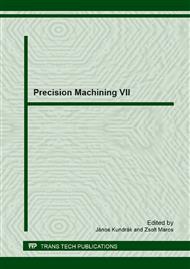[1]
D.A. Stephenson, J. S. Agapiou, Metal Cutting Theory and Practice, second ed., Taylor & Francis Group, (2006).
Google Scholar
[2]
J.W. Sutherland, V.N. Kulur, N.C. King, B.F. von Turkovich, An Experimental Investigation of Air Quality in Wet and Dry Turning, CIRP Annals - Manufacturing Technology 49 (2000) 61-64.
DOI: 10.1016/s0007-8506(07)62896-0
Google Scholar
[3]
A. T. Simpson et al., Occupational Exposure to Metalworking Fluid Mist and Sump Fluid Contaminants, Ann Occup Hyg. 47 (2002) 17-30.
DOI: 10.1093/annhyg/meg006
Google Scholar
[4]
D. Park, P. A. Stewart, J. B. Coble, Determinants of Exposure to Metalworking Fluid Aerosols: A Literature Review and Analysis of Reported Measurements, Ann Occup Hyg. 53 (2009) 271-288.
Google Scholar
[5]
M. Dado, Environmental risks associated with cutting fluids, Manufacturing Technology, 12 (2007) 33-36.
Google Scholar
[6]
A. Shokrani, V. Dhokia, S.T. Newman, Environmentally conscious machining of difficult-to-machine materials with regard to cutting fluids. Int J Mach Tools Manuf. 57 (2012) 83-101.
DOI: 10.1016/j.ijmachtools.2012.02.002
Google Scholar
[7]
M. Dado, Prediction models for cutting fluid mist generation, 3rd International conference ICTKI 2010, Ústí nad Labem, 5p.
Google Scholar
[8]
T. Thepsonthi, M. Hamdi, K. Mitsui, Investigation into minimal-cutting-fluid application in high-speed milling of hardened steel using carbide mills, International Journal of Machine Tools and Manufacture, 49 (2009) 156-162.
DOI: 10.1016/j.ijmachtools.2008.09.007
Google Scholar
[9]
J. P. Davim (ed. ), Green Manufacturing Processes and Systems, Materials Forming, Machining and Tribology, Springer, (2013).
Google Scholar
[10]
Klocke, F., Eisenblätter, G., Dry cutting, Ann. CIRP, 46 (1997).
Google Scholar
[11]
P. S. Sreejith, B.K.A. Ngoi, Dry machining: Machining of the future, J. Mat. Proc. Tech. 101 (2000) 287-291.
DOI: 10.1016/s0924-0136(00)00445-3
Google Scholar
[12]
L.N. Lopéz de Lacalle, C. Angulo, A. Lamikiz, J.A. Sánchez, Experimental and numerical investigation of the effect of spray cutting fluids in high speed milling, J. Mat. Proc. Tech. 172 (2006) 11-15.
DOI: 10.1016/j.jmatprotec.2005.08.014
Google Scholar


